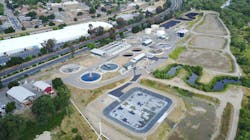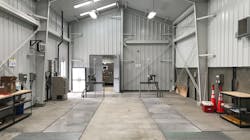Advancing Reuse Through Tertiary Treatment
Water agencies in California typically include water recycling in their water supply portfolios, but the ones that serve smaller populations may not be able to implement full-blown reuse programs all at once. The City of Paso Robles, home to approximately 30,000 residents, shows it’s possible to build water resilience without building an advanced purification plant. New tertiary treatment facilities at the 4.9 MGD Paso Robles Wastewater Treatment Plant (WWTP) showcase a sustainable approach to water management, advanced wastewater treatment, and cost-effective solutions for communities of any size. The new facilities yield high-quality recycled water as well as a struvite product that could be used as a fertilizer to supplement supplies through reclamation practices in an existing footprint. Tertiary treatment technologies and an advanced nutrient harvesting system boost the city’s resource resilience for both water and nutrients.
Completed in May 2019 with help from Black & Veatch, the new facilities yield Title 22-compliant recycled water for irrigation, serving as the first step in the city’s long-term plan to create a resilient, sustainable water supply.
Working — And Expanding — The Plan
Drought conditions and changing influent conditions necessitated Paso Robles’ WWTP upgrades, and the city’s 2014 Master Plan called for construction of tertiary treatment facilities to produce high-quality recycled water to irrigate public areas such as city parks and golf courses, as well as private sector wineries. The project team sought to optimize existing assets, incorporate flexibility, and minimize capital and future operating costs wherever possible.
Securing a low-interest Drinking Water State Revolving Fund (DWSRF) Loan and a $4 million Green Project Reserve grant for environmentally innovative endeavors helped Paso Robles upgrade the WWTP and resulting water quality through cloth media filtration and open channel ultraviolet (UV) disinfection. Currently, all the plant effluent complies with Title 22 requirements for irrigation and is stored in the on-site recycled water storage pond. This irrigation water will start serving a portion of the city parks and public areas within next two years as the city builds the distribution system infrastructure.
Prior to the Tertiary Treatment Facilities Project, plans were already in place to install a sidestream nutrient harvest system. The procurement and installation of the system was accelerated when struvite buildup was discovered by operators. The phosphorus laden filtrate from the digested sludge dewatering system was causing buildup of struvite in the pipes and inhibiting treatment processes.
Changing influent characteristics of the wastewater also contributed to the increase in the nutrient problem. Adding a system to effectively remove phosphorus and recover struvite essentially turned a nutrient nuisance into a future, marketable fertilizer to help the city offset project and operating costs.
Looking Back — And Ahead — At Resourceful Solutions
The project improved the plant’s physical and environmental footprint and serves as the first step in the city’s long-term plan to create a more resilient and sustainable water supply. The upgraded WWTP converts wastewater into Title 22-compliant recycled water for irrigation, a crucial move in supporting the city’s water resilience goals.
The nutrient harvesting system additionally improves water quality, protects infrastructure assets, and preserves the health of area water resources by recovering struvite. The expedited deployment of those facilities allowed Paso Robles to more quickly convert a nutrient nuisance into a beneficial product.
With a total cost of $14.4 million, the new facilities feature sustainable solutions that save energy and minimize chemical use. The innovative environmental features of the upgrade not only helped Paso Robles secure grant funding but also earned the City awards recognition. The California Water Environment Association recently named the Paso Robles Tertiary Treatment and Nutrient Harvesting System the 2019 Engineering Achievement of the Year. In addition, it is one of four projects shortlisted for the Global Water Awards’ 2020 Wastewater Project of the Year. WW
About the Author

Ashutosh Shirolka
Ashutosh Shirolkar, P.E., Black & Veatch Project Manager. His expertise includes planning, design, and construction of wastewater and recycled water treatment facilities, including biological nutrient removal technologies and advanced treatment technologies for indirect potable reuse.

Matt Thompson
Matt Thompson, P.E., is the Wastewater Resources Manager for the City of Paso Robles. He leads the implementation of the city’s water-sustainability vision.

Kaitie Zusy
Kaitie Zusy, P.E., is a Black & Veatch Project Engineer. She has worked on wastewater plants and recycled-water plants throughout California in sizes from 1 mgd to 120 mgd.

